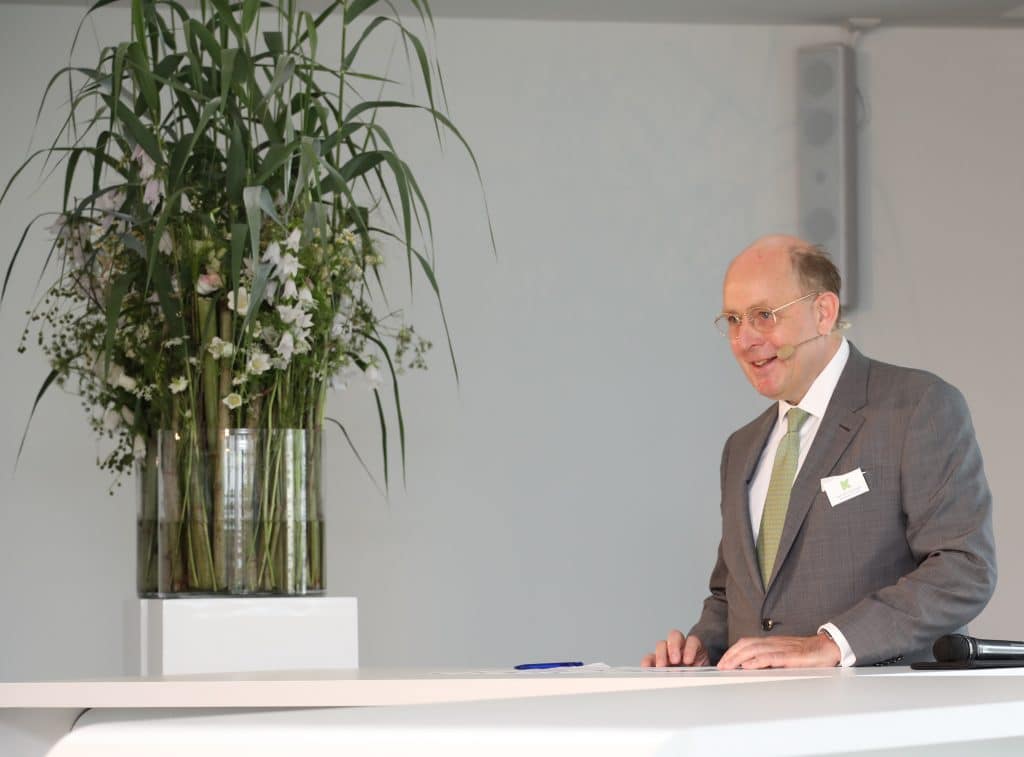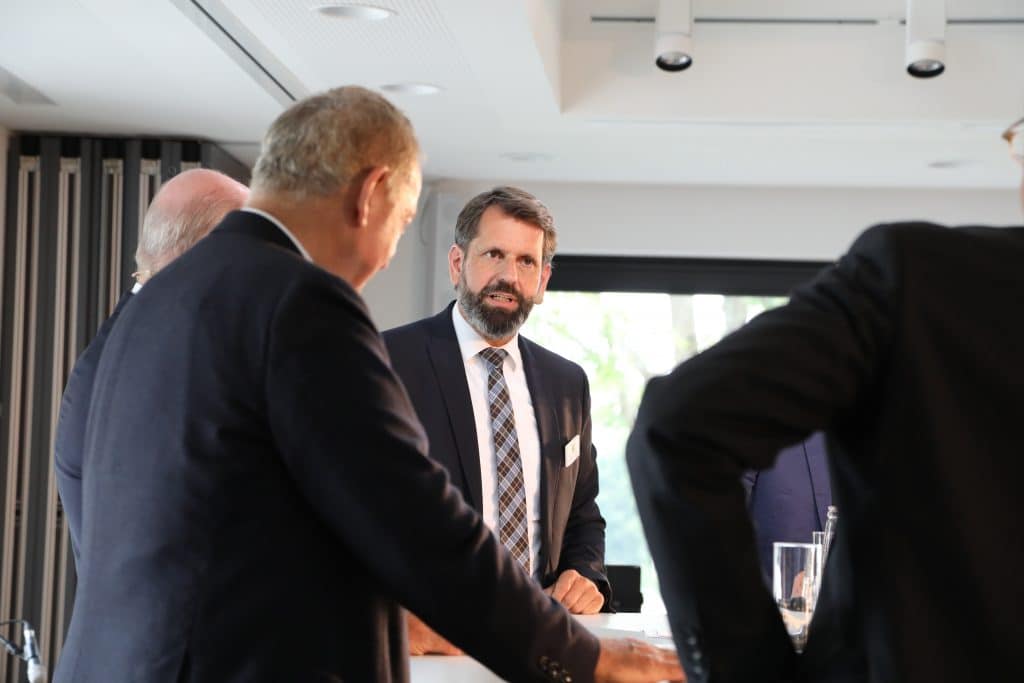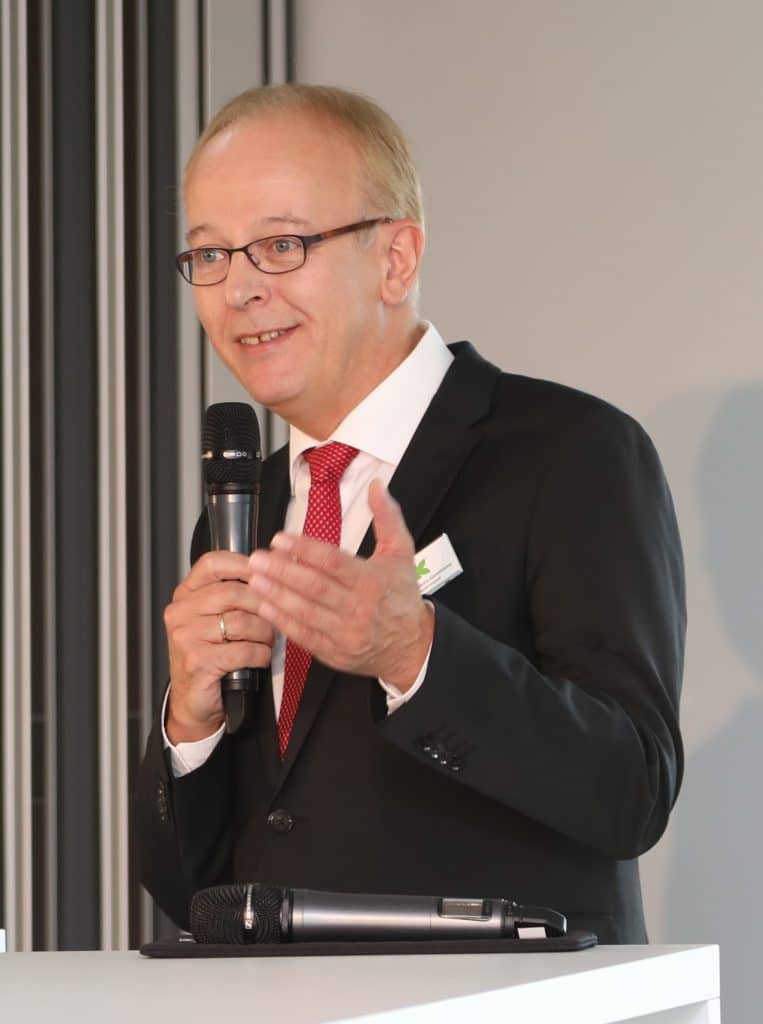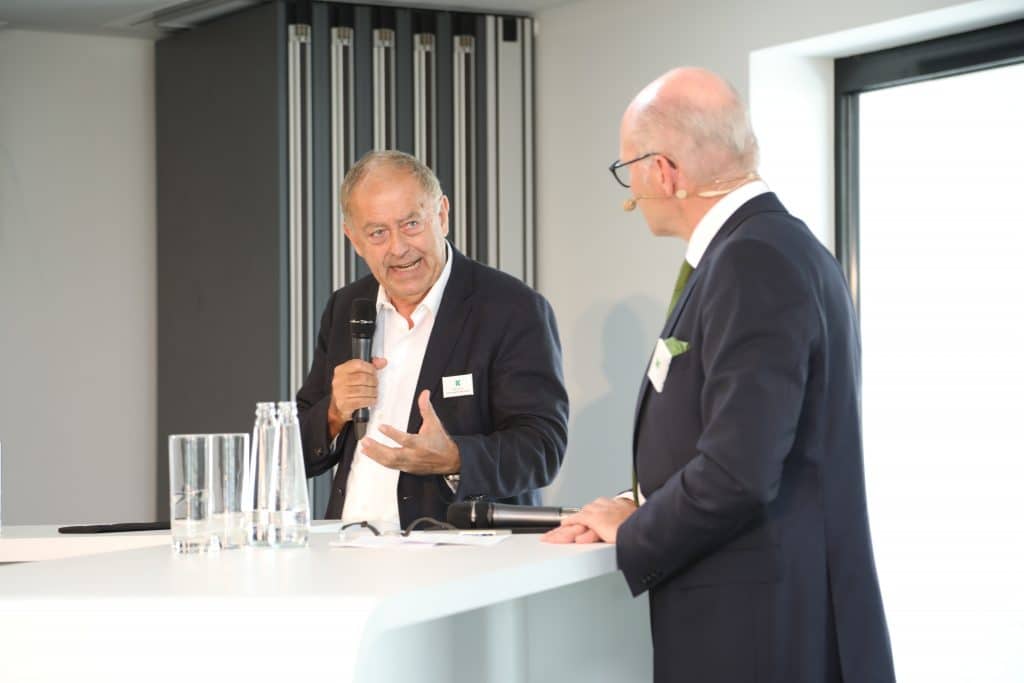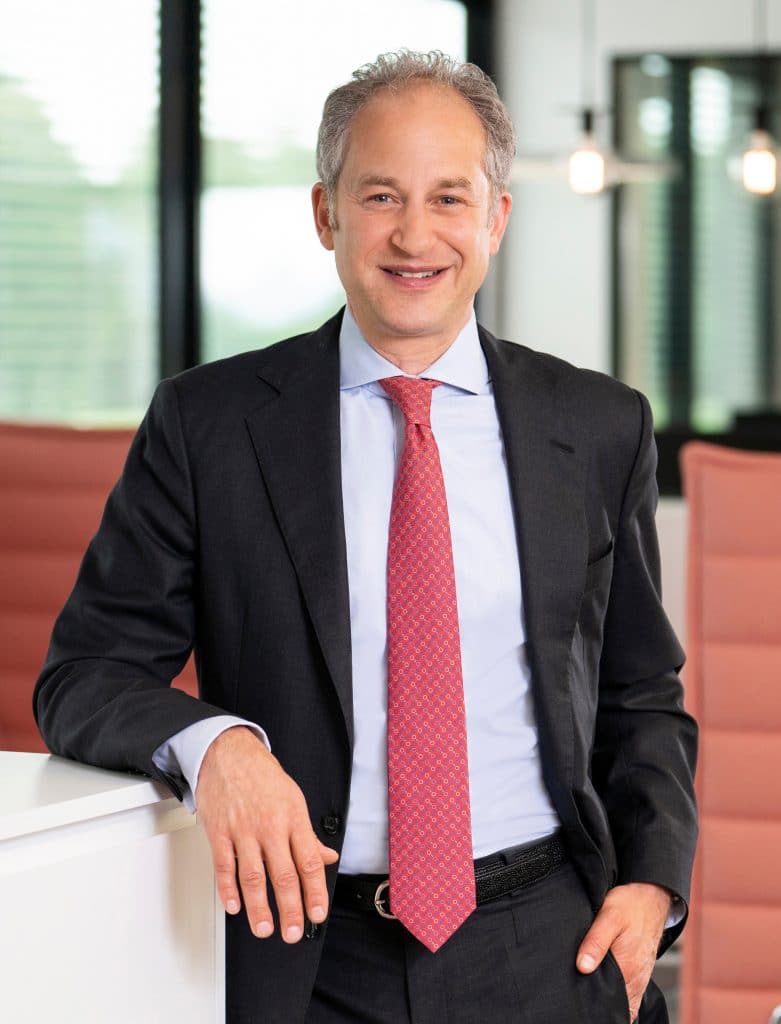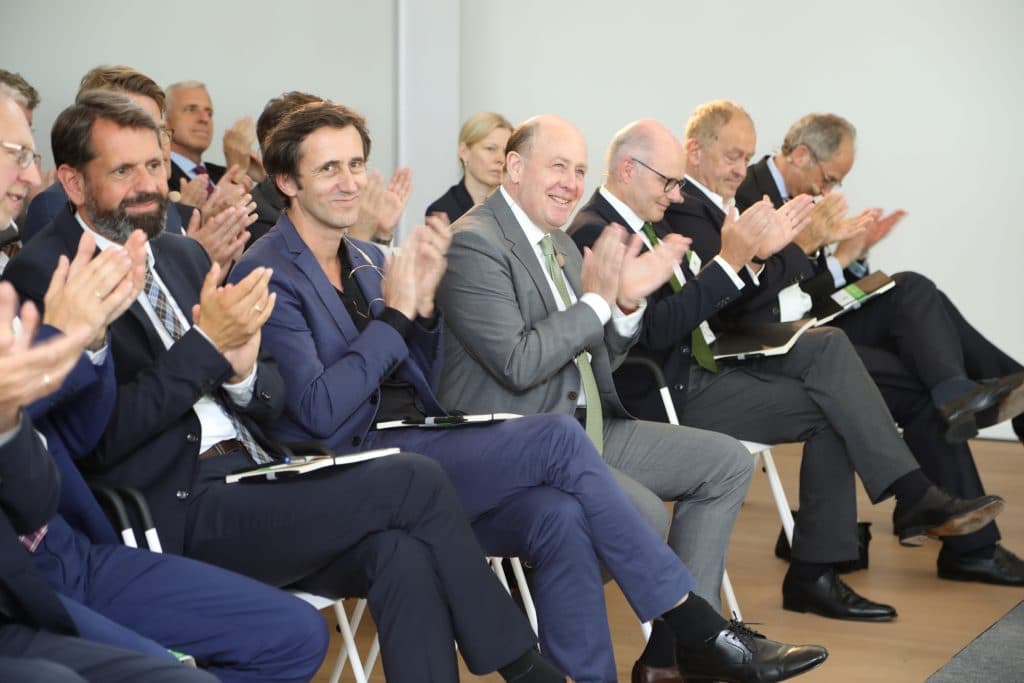Klasmann-Deilmann opens Innovation Center | Ceremony attended by many visitors from all over the world | Challenges faced in feeding a growing global population
“Innovation starts here.” The rationale behind the new building is clear, and Carl-Gerrit Deilmann, Chair of the Klasmann-Deilmann GmbH Administrative Board, put it in a nutshell. What is on Klasmann-Deilmann’s agenda are new growing media, new substrate constituents and new cultivation systems. And, from now on, this innovation will be set in motion at the Innovation Centre, which has now been officially opened.
An inauguration ceremony brought to an end the 18-month construction phase for Klasmann-Deilmann GmbH’s new building in Geeste, Germany. Visitors from all over the world had come here for the official celebrations, including business partners and customers from China, Taiwan, Argentina and Germany, as well as representatives from politics, the private sector and professional associations.
 In his ceremonial address, Carl-Gerrit Deilmann stressed that “Klasmann-Deilmann is very much bound up with the resource that is peat. However, our company is also seeking to explore completely new avenues. We have therefore located our new headquarters at a site that will, in the future, no longer have its own peat supply. This will spur us on to develop innovative products and business models. Klasmann-Deilmann has never been an organisation that watches things change. Klasmann-Deilmann is an organisation that makes things change.”
In his ceremonial address, Carl-Gerrit Deilmann stressed that “Klasmann-Deilmann is very much bound up with the resource that is peat. However, our company is also seeking to explore completely new avenues. We have therefore located our new headquarters at a site that will, in the future, no longer have its own peat supply. This will spur us on to develop innovative products and business models. Klasmann-Deilmann has never been an organisation that watches things change. Klasmann-Deilmann is an organisation that makes things change.”
 Lower Saxony’s Minister for the Environment, Olaf Lies (SPD), recalled his first visit to the company – back when he was Minister for Economic Affairs. He felt at ease here in both capacities, said Lies, as Klasmann-Deilmann is equally synonymous with business growth and with its efforts in the field of environmental and climate protection. He emphasised that investment in this new building is a good example of how the Emsland district authority serves as a role model. “Commercial success is always the result of wise locational choices by business enterprises,” he remarked, adding: “The nature of an office workplace is significant to a company’s skilled workers in ways that cannot be overstated. Modern work environments encourage creativity.” He therefore extended his praise to the new building’s architecture. Only the day before, he had presented Lower Saxony’s State Award for Architecture. On the one hand, he said, it was regrettable that the Innovation Center had not been in the running for this prize. On the other, he added with a smile, he hopes his own staff never get to see the attractive interior, otherwise they would never want to return to Hannover. In particular, Olaf Lies commended Klasmann-Deilmann for being so forward-looking in dealing extensively with tomorrow’s business models even today. “Unfortunately, by no means all companies give thought to such matters if things are currently going well.”
Lower Saxony’s Minister for the Environment, Olaf Lies (SPD), recalled his first visit to the company – back when he was Minister for Economic Affairs. He felt at ease here in both capacities, said Lies, as Klasmann-Deilmann is equally synonymous with business growth and with its efforts in the field of environmental and climate protection. He emphasised that investment in this new building is a good example of how the Emsland district authority serves as a role model. “Commercial success is always the result of wise locational choices by business enterprises,” he remarked, adding: “The nature of an office workplace is significant to a company’s skilled workers in ways that cannot be overstated. Modern work environments encourage creativity.” He therefore extended his praise to the new building’s architecture. Only the day before, he had presented Lower Saxony’s State Award for Architecture. On the one hand, he said, it was regrettable that the Innovation Center had not been in the running for this prize. On the other, he added with a smile, he hopes his own staff never get to see the attractive interior, otherwise they would never want to return to Hannover. In particular, Olaf Lies commended Klasmann-Deilmann for being so forward-looking in dealing extensively with tomorrow’s business models even today. “Unfortunately, by no means all companies give thought to such matters if things are currently going well.”
 Martin Gerenkamp, deputy district administrator for Emsland, brought greetings from the district’s CEO Reinhard Winter and the entire district authority. He looked back over the company’s long history: founded in 1913, it had been instrumental in the region’s development. Today, Klasmann-Deilmann is among the many ‘hidden champions’ that have emerged in the German SME scene and that are important not only in our home country but worldwide. The company is one of the major employers in the Emsland region. He especially appreciates that Klasmann-Deilmann had responded with intensified research and development activities to the decline in the traditional resource base and that, in the form of the Innovation Center, it had laid a real cornerstone for its future.
Martin Gerenkamp, deputy district administrator for Emsland, brought greetings from the district’s CEO Reinhard Winter and the entire district authority. He looked back over the company’s long history: founded in 1913, it had been instrumental in the region’s development. Today, Klasmann-Deilmann is among the many ‘hidden champions’ that have emerged in the German SME scene and that are important not only in our home country but worldwide. The company is one of the major employers in the Emsland region. He especially appreciates that Klasmann-Deilmann had responded with intensified research and development activities to the decline in the traditional resource base and that, in the form of the Innovation Center, it had laid a real cornerstone for its future.
 The guest speaker was economist and mathematician Professor Franz Josef Radermacher, a member of the Club of Rome, who addressed the prospects for and challenges inherent in feeding a growing global population, and discussed opportunities for the world’s climate and for soils that could arise from extensive carbon-sequestration measures. He stated that, 10,000 years ago, the Earth had been able to feed some 20 million people. Today, the global population is well into the billions, with a marked upward tendency. In fact, twice the current number of individuals could be fed, provided humanity adopts a vegetarian diet. Actually, however, much of the biomass produced is used for cattle farming; of the foodstuffs that go to feed the rich countries, “half consists of energy”. The key continent for the future of the planet – especially in terms of food supply and climate protection – is Africa which, because of its vast deserts and low population density, has the required potential to meet considerable challenges facing humankind. Here, it would be important to reverse desertification, carry out extensive afforestation, promote humus formation and improve soils in a sustained manner and on a large scale, by enriching them with biochar. This would be a ground-breaking approach in terms of climate, as CO2 would be removed from the atmosphere and remain in the soil long-term, with a positive impact for agriculture and forestry (carbon sequestration). With regard to commercial horticulture, Professor Radermacher said that the global population is reliant on “all aces being played”. This means that hydroponics systems, vertical farming and other innovative developments in the industry would be of growing importance.
The guest speaker was economist and mathematician Professor Franz Josef Radermacher, a member of the Club of Rome, who addressed the prospects for and challenges inherent in feeding a growing global population, and discussed opportunities for the world’s climate and for soils that could arise from extensive carbon-sequestration measures. He stated that, 10,000 years ago, the Earth had been able to feed some 20 million people. Today, the global population is well into the billions, with a marked upward tendency. In fact, twice the current number of individuals could be fed, provided humanity adopts a vegetarian diet. Actually, however, much of the biomass produced is used for cattle farming; of the foodstuffs that go to feed the rich countries, “half consists of energy”. The key continent for the future of the planet – especially in terms of food supply and climate protection – is Africa which, because of its vast deserts and low population density, has the required potential to meet considerable challenges facing humankind. Here, it would be important to reverse desertification, carry out extensive afforestation, promote humus formation and improve soils in a sustained manner and on a large scale, by enriching them with biochar. This would be a ground-breaking approach in terms of climate, as CO2 would be removed from the atmosphere and remain in the soil long-term, with a positive impact for agriculture and forestry (carbon sequestration). With regard to commercial horticulture, Professor Radermacher said that the global population is reliant on “all aces being played”. This means that hydroponics systems, vertical farming and other innovative developments in the industry would be of growing importance.
In the subsequent panel discussion, Moritz Böcking, Managing Director of Klasmann-Deilmann GmbH, expanded on Radermacher’s thoughts in terms of international commercial horticulture. He began by pointing out that the increasing worldwide demand for foodstuffs is taking on increasing significance for Klasmann-Deilmann, making it a key aspect of the company’s strategic focus. In 2017, some 45% of growing media produced were used directly for horticultural production of vegetables, fruit, herbs and edible mushrooms. Böcking put it more specifically: “It’s in vitamin-rich foods that we make our contribution. Which means: foods that are healthy.”
 He pointed out that substrates have a stabilising role in the rooting zone, act as nutrient buffers and water stores, making them the reliable foundation for high-yielding plant growth. “This is especially important when you know precisely where our strength lies: we’re unbeatable when it comes to substrates for propagating young plants. This means we’re there for the initial phase in a plant’s growth; our contribution is at the stage that is crucial for a plant’s further development and yield,” Böcking said. He conceded that salad crops and vegetables play more of a secondary role when the emphasis is on feeding a rapidly growing population, as in Africa: “In many regions of the world the current priority is not so much vitamins but staple carbohydrate foodstuffs, the focus being on arable crops. Which means: food that fills stomachs.”
He pointed out that substrates have a stabilising role in the rooting zone, act as nutrient buffers and water stores, making them the reliable foundation for high-yielding plant growth. “This is especially important when you know precisely where our strength lies: we’re unbeatable when it comes to substrates for propagating young plants. This means we’re there for the initial phase in a plant’s growth; our contribution is at the stage that is crucial for a plant’s further development and yield,” Böcking said. He conceded that salad crops and vegetables play more of a secondary role when the emphasis is on feeding a rapidly growing population, as in Africa: “In many regions of the world the current priority is not so much vitamins but staple carbohydrate foodstuffs, the focus being on arable crops. Which means: food that fills stomachs.”
At the same time, he said, observation of population and other trends in countries such as China shows that growing affluence results in dietary changes: “All-year-round availability of vegetables or fruit then takes on a new significance – and justifiably so. And it is precisely here that we see our potential. The players in commercial horticulture, of which we are one, pursue the common goal of ensuring a balanced, healthy diet. Ultimately, it is consumers that benefit from healthy foods. In terms of achieving sustainability, this is a good line of business that we are, with our innovations, helping to move forward,” concluded Moritz Böcking.
Interior designer Gunter Fleitz – who played an instrumental role in shaping the Innovation Center – remarked that, unfortunately, there is no single blueprint by which businesses can promote the kind of innovation needed for industries such as the international food sector. At the same time, he was confident that the ‘places for interaction’ created within the Innovation Center, as well as the embracing of openness and transparency, would definitely enhance the work environment and contribute to the desired innovation. There is interplay, he said, between employees’ mental agility on the one hand, and the look, touch, feel and sound of a workplace on the other. Fleitz put it in a nutshell: innovation emerges from a sense of wellbeing.
 The reason for Klasmann-Deilmann’s major investment in this new structure is its continuous growth. For some years, the previous administrative building no longer had sufficient space. In the Innovation Center, additional PC workstations and open-plan areas are now in place for more than 40 employees. It houses an Academy and a multimedia exhibition area, thus providing a suitable setting for events. In this new building, central functions are brought together. The Group will henceforth be managed from here, and strategic and international cooperation strengthened – both within the Klasmann-Deilmann Group and with partners, customers and stakeholders. A modern experimental greenhouse called the Research Center was also purpose-built in the immediate vicinity for research projects – some of them already underway – on innovative growing media, cultivation systems and substrate constituents. The entire location is thus geared towards research, development and innovation.
The reason for Klasmann-Deilmann’s major investment in this new structure is its continuous growth. For some years, the previous administrative building no longer had sufficient space. In the Innovation Center, additional PC workstations and open-plan areas are now in place for more than 40 employees. It houses an Academy and a multimedia exhibition area, thus providing a suitable setting for events. In this new building, central functions are brought together. The Group will henceforth be managed from here, and strategic and international cooperation strengthened – both within the Klasmann-Deilmann Group and with partners, customers and stakeholders. A modern experimental greenhouse called the Research Center was also purpose-built in the immediate vicinity for research projects – some of them already underway – on innovative growing media, cultivation systems and substrate constituents. The entire location is thus geared towards research, development and innovation.
“We wanted to create a forward-looking work environment that enables dialogue and transparency; one that creates an atmosphere conducive to innovation,” commented Moritz Böcking.

The event was hosted by Dr Markus Baumanns, who heads consultancy ‘company companions GmbH’ and is a member of Klasmann-Deilmann’s Administrative Board. Music for the occasion was furnished by Hamburg-based singer Katrin Wulff who, with her band, provided varied entertainment. The highlight was a song entitled ‘The Future Is Getting A New Home’, specially composed for the opening festivities, which prompted a particularly warm round of applause.
We are especially grateful to:
- Carsten Klemp, Director Procurement & Technology and ‘Project Leader Innovation Center’ at Klasmann-Deilmann;
- Professor Hans-Georg Stotz of architects Beyer Weitbrecht Stotz, who was the project architect;
- Thomas Borgmann and Michael Kröger of architectural and engineering agency pbr Planungsbüro Rohling AG who, with their team, were in charge of the project’s execution;
- Gunter Fleitz and Johanna Bopp of identity architects Ippolito Fleitz Group GmbH, who developed the interior design;
- Karsten Gogsch with his team from engineering firm LINDSCHULTE Ingenieurgesellschaft mbH, who designed the outdoor facilities;
- Peter Walter of ProBau who was involved as project controller on behalf of the client;
- Hubert Kewe Jr. of building contractor Hubert Kewe GmbH, who executed the structural engineering and the outdoor facilities;
- Johannes Marsmann of greenhouse construction contractor Hans Marsmann Gewächshausbau GmbH, who built the Research Center;
- Andreas Lake of building services engineering company Heinrich VOSS Gebäudetechnik GmbH, who oversaw work on the woodchip heating system;
- Johanna Dagen and Frederik Behrend of consultancies Averes Bürotechnik and ambiente b respectively, who were responsible for the building’s interior decoration and furnishing.
Facts and figures on the Innovation Center:
The Innovation Center itself:
- Modern work environment with open-plan areas and individual offices for up to 60 employees
- Academy
- Conference rooms
- Multimedia exhibition area
- Canteen
- Total gross floor area: 3,330 m²
- Basement: 520 m²
- Ground and upper floors: 2,810 m²
- Total usable floor area: 2,400 m²
- Energy standard: KfW Effizienzhaus 55
- Annual primary energy consumption: 82.6 kWh/(m²a)
- Reference building for comparison: 172.9 kWh/(m²a)
Research Center:
- Research greenhouse: 430 m²
- Research subject matter: growing media, substrate constituents, growing systems
Woodchip heating
- for Innovation Center and Research Center: 200 kW
